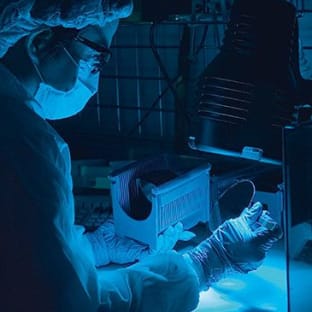Research & Development
Faster, thinner, more powerful – tailored solutions for customers are the basis for our long-term success. In order to remain successful and continue to grow in the progress- and innovation-driven semiconductor market and related markets, we expanded our research and development activities in the past fiscal year. All product lines benefited from our increased development activities and intensive cooperation with leading research facilities and universities.
Together with leading research institutes worldwide SUSS is exploring at the forefront of technology development.
In alphabetical order:

blz (Bayerisches Laser Zentrum)
The blz (Bavarian Lasercenter GmbH) is a research institute under private law in the surroundings of the Friedrich-Alexander University Erlangen-Nuremberg (FAU). www.blz.org

Fraunhofer IISB
The Fraunhofer Institute for Integrated Systems and Device Technology (IISB), founded in 1985, conducts applied research and development in the fields of micro- and nanoelectronics, power electronics, and mechatronics. With its technology, device, and material development, its activities in the field of simulation as well as its works on power electronic systems for energy efficiency and hybrid and electric vehicles, the institute enjoys international attention and recognition. www.iisb.fraunhofer.de

Fraunhofer IST
As an industry-oriented R&D service center the Fraunhofer Institute for Surface Engineering and Thin Films IST bundles skills and expertise in the fields of coating production, coating application, coating characterization, and surface analysis. The use of thin films can bring about major improvements in the functionality, quality, and application possibilities of products as well as in production processes in industrial and newly industrialized countries. www.ist.fraunhofer.de

Fraunhofer IOF
The Fraunhofer IOF conducts application-oriented research in the field of optical systems engineering on behalf of its clients in industry and within publicly-funded collaborative projects.
The Fraunhofer IOF provides the entire process chain, starting from system design to manufacture of prototype optical, optomechanical, and optoelectronic systems. www.iof.fraunhofer.de

Fraunhofer IZM
Fraunhofer IZM specializes in industry-oriented applied research. With four technology clusters, Fraunhofer IZM covers the entire spectrum of technologies and services necessary for developing reliable electronics and integrating new technology into applications. Our customers are as varied as the applications for electronics. We take on development projects for the automotive industry, healthcare and industrial electronics and even textile companies. www.izm.fraunhofer.de

Friedrich- Alexander University of Erlangen, ODEM (Optical Design, Measurement and Micro Optics)
The working fields of the group ODEM are optical design and the development of innovative simulation tools (geometrical optical and wave optical methods), microstructuring (for example the fabrication of diffractive optical elements by laser lithography or electron beam lithography) and optical measurement techniques (for example the absolute testing of aspheric surfaces).
www.optik.uni-erlangen.de/odem/

IMEC
IMEC is a world-leading independent research center in nanoelectronics and nanotechnology. IMEC's research bridges the gap between the fundamental research at universities and R&D in the industry. www.imec.be

ITRI
Industrial Technology Research Institute (ITRI) – a national research organization that serves to strengthen the technological competitiveness of Taiwan. www.itri.org.tw/eng/

MFA (Research Institute for Technical Physics and Materials Science)
The institute focuses on interdisciplinary research on complex functional materials and nanometer-scale structures, exploration of physical, chemical and biological principles, their exploitation in integrated micro- and nanosystems, and in the development of characterization techniques. www.mfa.kfki.hu

University of Kassel - INA (Institute of Nanostructures Technologies and Analytics)
For more than 10 years, the institute has been working on research and development of optical and opto-electronical devices with micro- and nanostructure technologies.
We use semiconductor technologies as Molecular Beam Epitaxy (MBE), several deposition techniques, wet- and dry-chemical etching technologies, focussed ion beam (FIB) technologies and optical lithography, electron beam lithography and nanoimprint lithography. Laboratory facilities for our analytics section are a further important part of our institute. www.te.ina-kassel.de
